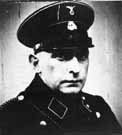
|
|
|

|

|

|

|
|
Click on an image to see a larger, more detailed picture.
|
|
|
|
|
| 1941: Mass Murder |

|
pg. 270 |

|
|
|
|
| |
 Among the most infamous mass executions perpetrated by the Germans during the war was that at Babi Yar, a ravine near Kiev, Ukraine. On September 29 and 30, 1941, the Germans, with the aid of Ukrainian collaborators, rounded up and executed 33,771 Jews at Babi Yar. This massacre was one of many carried out by German Einsatzkommandos and police regiments following the invasion of the Soviet Union.
Among the most infamous mass executions perpetrated by the Germans during the war was that at Babi Yar, a ravine near Kiev, Ukraine. On September 29 and 30, 1941, the Germans, with the aid of Ukrainian collaborators, rounded up and executed 33,771 Jews at Babi Yar. This massacre was one of many carried out by German Einsatzkommandos and police regiments following the invasion of the Soviet Union.
Photo: Hessisches Hauptstaatsarchiv / United States Holocaust Memorial Museum Photo Archive
|
 Paul Blobel was commander of Sonderkommando 4a of Einsatzgruppe C, which carried out numerous atrocities in the Ukraine during the summer and fall of 1941, among them the Babi Yar massacre. He also headed another enormous massacre at Kharkov, Ukraine, in late December 1941. More than 21,600 Jews were slaughtered.
Paul Blobel was commander of Sonderkommando 4a of Einsatzgruppe C, which carried out numerous atrocities in the Ukraine during the summer and fall of 1941, among them the Babi Yar massacre. He also headed another enormous massacre at Kharkov, Ukraine, in late December 1941. More than 21,600 Jews were slaughtered.
Photo: United States Holocaust Memorial Museum Photo Archive
|
 Massacre at Babi Yar
Massacre at Babi Yar
Days after the German Army captured Kiev, Ukraine, the bloodiest shooting massacre of the Holocaust took place on the outskirts of that city. Over the course of two days in September 1941, Einsatzgruppen and Security Police commandos slaughtered more than 33,000 of Kiev's Jews at a ravine called Babi Yar. When a series of explosions and fires in Kiev killed many German soldiers and destroyed army headquarters, Jews were blamed. In retaliation, German authorities posted a sign announcing a supposed "resettlement" of the city's Jews. Under threat of death, more than 30,000 were marched to the Jewish cemetery. From there they were marched in small groups to Babi Yar. Stripped of all clothing, the trembling Jews were led into the ravine. Ordered to lie down, each was shot in the back of the head. The massacre continued uninterruptedly. New victims were forced to lie on those already dead. Corpses stacked up in layers. A survivor recalled being miraculously untouched by the bullets but, clutching her son to her naked body, fell under "a heap of warm, bloody bodies. The bodies of old men rested on the bodies of children, who lay on the bodies of their dead mothers." Commander Paul Blobel later attempted to obliterate all traces of the massacre.
Photo: Archive Photos
|
|

|

|

|

|
 Early October 1941: Seventy children in the Warsaw Ghetto are found frozen to death outside destroyed houses following the season's first snowfall.
Early October 1941: Seventy children in the Warsaw Ghetto are found frozen to death outside destroyed houses following the season's first snowfall.
|
 October 1-December 22, 1941: 33,500 Jews are killed in Vilna, Lithuania.
October 1-December 22, 1941: 33,500 Jews are killed in Vilna, Lithuania.
|
 October 2, 1941: On this Jewish Day of Atonement, Jews are taken from the ghetto at Podborodz, Ukraine, and killed.
October 2, 1941: On this Jewish Day of Atonement, Jews are taken from the ghetto at Podborodz, Ukraine, and killed.
|
 October 2, 1941: A Nazi raid on the Jewish ghetto at Vilna, Lithuania, leaves 3000 dead at nearby Ponary. One victim, Serna Morgenstern, is shot in the back by an SS officer after he complimented her beauty and told her she was free to go.
October 2, 1941: A Nazi raid on the Jewish ghetto at Vilna, Lithuania, leaves 3000 dead at nearby Ponary. One victim, Serna Morgenstern, is shot in the back by an SS officer after he complimented her beauty and told her she was free to go.
|
|
|
|
|
| 1941: Mass Murder |

|
pg. 270 |

|
|
The Holocaust Chronicle
© 2009 Publications International, Ltd.
|
|
